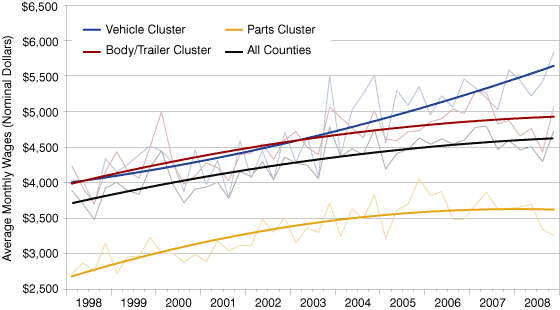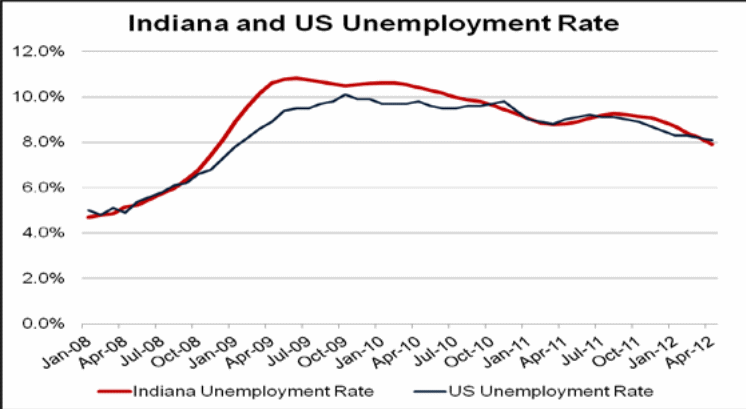Introduction
According to Matt (2012), Indiana is one of the states in the U.S., established in 1816. The state covers 94,321square kilometers. It borders Michigan to the north, Ohio to the east, and Illinois to the west. Indiana ranks position 15 of the most populated states in the United States. In 2010, Indiana had a population of 6,483,802 people. The population density during the same year was 180.1 persons in a square mile. Statistics indicated that the racial composition was: Whites (84.3%), African-American (9.1%), and Asian (2.1%). Other small groups of people were Native Americans (0.4%), Hispanic (6.0%) and biracial individuals (2.1%).
Individuals aged 18 years and below were recorded to be 25%, while people aged 65 years and above formed 13% of the population. This indicates that most of the people in the state are middle aged. This represents the working class of people in the state. Therefore, it is notable that, most of the people in the Indiana state are productive economically. Indianapolis is the biggest city, while Mississippi River is the second largest town in the state. The economy of Indiana economy is diversified. In 2005, the GDP of the country was $214 billion. The state has a metropolitan population, and there are several smaller cities (Murphree, 2012).
Source: United States Census Bureau, (2012).
The manufacturing industry forms the largest percentage of the GDP of the Indiana state. Calumet, which is located towards the northwest of the state, produces the largest amount of steel. Other products manufactured in the state are automobiles, electrical machines, transport equipment, medical tools, petroleum and other products. The manufacturing industry is growing at a fast rate, and this has attracted a large number of skilled, semiskilled and unskilled workers. The increasing number of people seeking employment in the region has necessitated the establishment of education and training centers. These centers offer training and education to the large number of people seeking jobs in the state, especially in the manufacturing industry (Murphree, 2012).
The constitution of the Indiana state offers a public school system, which is funded by the state. A large number of children (90%) in Indiana attend public schools, while others attend private schools (10%). Indiana University is the largest education center in the state. Other universities in the state are Purdue University, Vincennes University and ball state university and university of south Indiana.
In addition, there are private universities and colleges, which are mostly associated with religious groups. The universities and colleges in Indiana offer diversified courses. This has promoted the labor force of the state because many students get employed in most of the industries in the state. The state has many support services, such as health centers, food services, sports and others. These services support the people working in the state. As such, the state has managed to offer quality services to the workforce (Murphree, 2012).
The workforce development needs in Indiana
Employment patterns in Indiana indicate that the workforce lacks enough skills to work in the automotive industry. The automotive industry is a sub-industry in the manufacturing industry, which is the leading source of employment in the state. There are two categories of employees in the automotive industry of Indiana: The employees working on vehicle parts and those working on complete vehicles. It has been noted that the subsector related to manufacture of complete vehicles employs few people.
On the other hand, the subsector manufacturing vehicle parts is the leading employer. However, there is a gap in the skills possessed by the people in Indiana. As such, most of the people lack employment because their skills do not match the market needs. Therefore, there are training needs to the workforce in the region. This requires the government to increase the number of people with skills of manufacturing vehicle parts by a greater number than those manufacturing complete vehicles. This will create a balance between the jobs available in the economy, and the skills of the employees.
This scenario is illustrated by the fact that, in 2008, the automotive industry employed 58% people in companies that manufacture vehicle components. Approximately 29.6% of the workers in the industry manufactured frames of vehicles were employed. The company’s manufacturing complete vehicles employed 12,720 people, which is about 12.4%. The statistics shows that the subsector manufacturing vehicle parts is the leading employer in the Indiana economy. On the other hand, the subsector manufacturing complete vehicles is lagging behind (Thompson & Merchant, 2012).
Another problem facing employees in the automotive industry is low wage growth. In addition, employees in the different subsectors earn different wages, and the wage growth is also different. Employees working in the complete vehicles earn more wages than the other employees. It is also evident that the wage growth is faster to employees working in the complete vehicles subsector. As such, there is a need for realignment of wages by the government. Creating a system where all employees earn the same incomes, with equal wage growth will ensure that people are attracted to all sectors equally.
The scenario being experienced in the Indiana state makes people train on skills related to complete vehicle manufacturing, whereas the sector can offer few jobs. People shy away from acquiring skills in the vehicle parts subsector because there are low wages and low wage growth. It is worrying to note that this sector offers the most jobs, but few people are training to work in the subsector. This imbalance has resulted to unemployment in the Indiana state. The government should intervene by providing equal wages and equal wage growth to all sectors in the industry. This will ensure that people train in all subsectors and that the unemployment is reduced.

In the graph above, it is important to mention that the wage rates increased slowly for employees in all the subsectors for the period from 1998 to 2008. The parts cluster had the lowest wage rates, while the vehicle cluster had the highest wage rates. The body/trailer cluster had relatively high wage rates in the beginning, but the wage rates declined from 2003 towards 2008. An increasing trend in the wage rates was recorded in all the counties in Indiana (Thompson & Merchant, 2012).
Since the automotive industry offers employment to a large number of people in the parts subsector, the institutions that offer education and training should focus on educating people on how to manufacture automobile parts. A lot of emphasis should be placed on the parts manufacturing because many people can be employed in this subsector. On the other hand, the complete vehicle subsector should not be ignored. This will help promote the complete vehicle manufacturing, while avoiding a scenario whereby there are many people with skills, but they remain unemployed. These strategies will help the government to promote the level of employment in Indiana. As such, the income levels and the living standards of the people in the region will be promoted (Stiglitz & Walsh, 2006).
Review of the unemployment statistics
The rate of unemployment in Indiana is reducing. The creation of new jobs has been growing tremendously in the recent past. For instance, in April 2012, 15400 new jobs were created. The manufacturing industry created 6200 new jobs during the same period. From the graph below, it is evident that the rate of unemployment was lowest at the beginning of 2008. The rate of unemployment increased in 2009 to attain a climax in mid-2009. The rate of unemployment started to decline towards the end of 2009.
Currently, unemployment is declining, even though it is still high. By April 2012, the rate of unemployment was 8%. This indicates that the government has put adequate measures to reduce the rate of unemployment. In comparison to the U.S. the rate of unemployment in Indiana has been slightly above that of the general US economy (Indiana Department of workforce Development, 2012).

Employment in the automotive industry in Indiana has a lot of relevance on the growth of GDP of the economy. Therefore, the government should make appropriate decisions concerning the training and education needs of employees in this industry. It is evident that unemployment in the industry has been declining from 1998 to 2008. This shows that there is the need to intervene in the industry to ensure that many people are employed and that the growth in the employment rate is maintained to sustain the employees in the industry. In addition, the wage rates have been increasing. This is a clear sign that the people employed in the industry are benefiting from the increasing incomes over the years (Hughes & Cain, 2011).
Sources used
Several sources, from the region, were used in gathering the data used in writing the report. Nationally, the United States Census Bureau was used to compare the statistics of Indiana with other neighboring states. The general perspective of the Indiana state was developed by the use of the national websites; such as Indiana Department of workforce Development. In addition, the book “American economic history” provides a general overview of the economic status of Indiana.
The book provides a proper picture of the economy of Indiana. Analysis of the economy of Indiana is provided by the website “History of Indiana Business Research Center.” Business activities in Indiana have been analyzed by IBRC. In addition, the history of IBRC has been provided. The subsectors in the automotive industry in Indiana have been analyzed by the website “Segmenting Indiana’s Automotive Manufacturing Industry: Jobs and Wages.” The site provides information about the subsectors in the automobile industry.
References
Hughes, J. R. T., & Cain, L. P. (2011). American economic history. Boston: Addison-Wesley.
Indiana Business Research Center (2012). History of Indiana Business Research Center. Web.
Indiana Department of workforce Development (2012). Indiana leads the nation in job growth. Web.
Matt, P. (2012). World Population Review. Web.
Murphree, D. S. (2012). Native America: A state-by-state historical encyclopedia. Santa Barbara, Calif: Greenwood.
Stiglitz, J. E., & Walsh, C. E. (2006). Economics. New York, NY [i.e.: Norton.
Thompson, M. F. & Merchant, A. A. (2012). Segmenting Indiana’s Automotive Manufacturing Industry: Jobs and Wages. Web.
United States Census Bureau, (2012). Population estimates. Web.